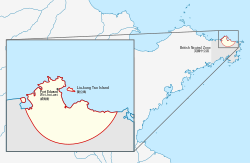Weihaiwei 威海衛 | |||||||||
|---|---|---|---|---|---|---|---|---|---|
| 1898–1930 | |||||||||
| Anthem: God Save the Queen (1898–1901) God Save the King (1901–1930) | |||||||||
 Location of Weihaiwei (blue) in 1921 | |||||||||
 Location of Weihaiwei in Shandong | |||||||||
| Status | Leased territory of the United Kingdom | ||||||||
| Capital | Port Edward | ||||||||
| Common languages | |||||||||
| Government | |||||||||
• Monarch | Victoria (first) George V (last) | ||||||||
| Sir Arthur Dorward (first) Sir Reginald Johnston (last) | |||||||||
| Historical era | New Imperialism | ||||||||
| 1 July 1898 | |||||||||
| 30 September 1930 | |||||||||
| Area | |||||||||
| 746 km2 (288 sq mi) | |||||||||
| Currency | Customs gold unit Hong Kong dollar (joint circulation) | ||||||||
| |||||||||
| British Weihaiwei | |||||||||||
|---|---|---|---|---|---|---|---|---|---|---|---|
| Traditional Chinese | 威海衛 | ||||||||||
| Simplified Chinese | 威海卫 | ||||||||||
| Literal meaning | powerful sea guard | ||||||||||
| |||||||||||
Weihaiwei or Wei-hai-wei, on the northeastern coast of China, was a leased territory of the United Kingdom from 1898 until 1930. The capital was Port Edward, which lay in what is now the centre of Huancui District in the city of Weihai in the province of Shandong. The leased territory covered 288 square miles (750 km2)[1] and included the walled city of Weihaiwei, Port Edward just to the north, Weihaiwei Bay, Liu-kung Island and a mainland area of 72 miles (116 km) of coastline running to a depth of 10 miles (16 km) inland, an area roughly coterminous with the Huancui District of modern Weihai City. Together with Lüshunkou (Port Arthur) it controlled the entrance to the Bohai Sea and, thus, the seaward approaches to Beijing.[2]
- ^ pp.462-463 Hutchings, Graham Modern China: A Guide to a Century of Change Harvard University Press, 1 Sep 2003
- ^ Kowner, Rotem (2006). Historical Dictionary of the Russo-Japanese War. The Scarecrow Press. ISBN 0-8108-4927-5. p. 417-418.
